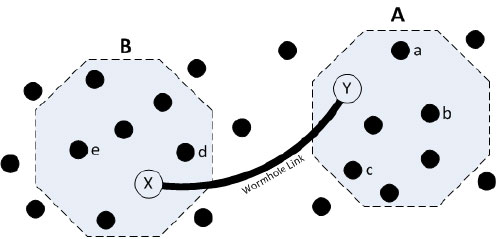The Wormhole attack in wireless sensor networks
The idea behind the Wormhole attack is to forward data from one compromised node to another malicious node on the other end of the network through a tunnel. Therefore, other nodes in WSN may be tricked into believing that they are closer to other nodes than they really are, which can cause problems in the routing algorithm.
In addition, the compromised nodes can intercept the packets. The Wormhole attack can also be combined with a Sinkhole attack to make it more effective.
Wormhole attacks
 The Wormhole attack is a type of network layer attack that is performed using multiple malicious nodes
The Wormhole attack is a type of network layer attack that is performed using multiple malicious nodes
The Wormhole attack can be classified into three main categories:
1. Attack the open Wormhole
In this case, the data packets are first sent from the source to a wormhole to move them to another wormhole, and then to the destination. The other nodes in the network are ignored and cannot be used to transmit data.
2. Attack the half-open Wormhole
In this case, data packets are sent from the source to a wormhole to transmit them directly to the destination.
3. Attack the closed Wormhole
In this case, the data packets are passed directly from source to destination in a single hop, making them fake neighbors.
How to cope with Wormhole attacks?
Some of the countermeasures for Wormhole attacks are:

1. Watchdog model
According to the Watchdog model if some information is passed from one node to another through a central node, the sending node checks the middle node. If the middle node does not send a packet within the set time limit it is declared fake, and a new path to the destination node is created.
Although in this method, the Watchdog node is not always accurate in wormhole detection and can be deceived easily, if the Wormhole attack is combined with a Selective Forwarding attack (selective forwarding). ). The probability of an inaccurate warning is also quite high here.
2. The Delphi technique
In this method, the latency per hop in the WSN is calculated and it is clear that the tunnel will be longer than the normal path. So if the latency per hop of any path is significantly greater than the average then the network is considered under attack. This method is not very successful if there is a large number of wormholes in WSN, because with the increase of wormholes the average latency per hop will increase significantly.
3. Wormhole Resistant Hybrid technique
This model is a combination of Watchdog and Delphi methods and also overcomes their limitations. This method tracks both: data loss and latency per hop, and is designed to detect all types of wormholes.
4. Explore separate route algorithm
This algorithm discovers different paths between two nodes to identify a Wormhole attack. It finds all single and double hop neighbors, as well as most routes between nodes. So it can be easy to check if a node that claims to be the shortest path to the destination is correct.
5. Packet Leash
The Packet Leash prevents the transmission of packets over long distances. They are also divided into:
(i) Geographical Leash - Ensures that data cannot be transmitted more than a specific distance in a hop.
(ii) Temporal Leash - Set a limit for the total distance the data packet can travel even with multiple hops.
You should read it
- What is Sensor Network Architecture?
- What is WBAN (Wireless Body Area Network)?
- Basic guide: wireless network - Wireless
- Learn SSID and wireless network
- Basically about Wireless Networking
- What is 51% attack? How does 51% attack work?
- Learn about basic WLAN devices
- 4 steps to set up your home wireless network
May be interested
- Restrict wireless access
 in this article we have introduced some ways to prevent, or in other words, restrict wireless access, to secure some wi-fi networks.
in this article we have introduced some ways to prevent, or in other words, restrict wireless access, to secure some wi-fi networks. - Sony developed a camera sensor 'like the human eye'
 while all current camera sensors are flat in shape, sony has developed a new imaging sensor that imitates the eye of the eye: a curved, cmos sensor ....
while all current camera sensors are flat in shape, sony has developed a new imaging sensor that imitates the eye of the eye: a curved, cmos sensor .... - Set up Ad Hoc wireless network to play WiFi without software from your laptop
 creating ad hoc wireless networks is simple and easy, it will take you less than a minute to create ad hoc wireless networks on your laptop. but before doing wifi sharing with ad hoc, you should know what this ad hoc wireless network feature is and which laptop can create ad hoc?
creating ad hoc wireless networks is simple and easy, it will take you less than a minute to create ad hoc wireless networks on your laptop. but before doing wifi sharing with ad hoc, you should know what this ad hoc wireless network feature is and which laptop can create ad hoc? - Wireless LAN technologies and Microsoft Windows
 the purpose of this article is to describe the advantages of wireless lan supported with 802.11® security and technology standards in microsoft® windows® and general wireless lan guidance in medium and large organizations, networks small office.
the purpose of this article is to describe the advantages of wireless lan supported with 802.11® security and technology standards in microsoft® windows® and general wireless lan guidance in medium and large organizations, networks small office. - Set up wireless network
 after regularly using a wireless connection on a windows 7 system, you will have a list of saved wireless networks connected.
after regularly using a wireless connection on a windows 7 system, you will have a list of saved wireless networks connected. - 8 tips to secure wifi wireless networks for businesses and families
 hackers can eavesdrop on devices using public wifi networks, leading to the disclosure and theft of sensitive information, passwords, emails, etc. so immediately apply the 8 ways to secure your wireless network below.
hackers can eavesdrop on devices using public wifi networks, leading to the disclosure and theft of sensitive information, passwords, emails, etc. so immediately apply the 8 ways to secure your wireless network below. - Guide to DD-WRT - Part 2: Extending scope with WDS
 a wireless distribution system (wireless distribution system), is an economical and easy solution that can extend the coverage of wireless networks.
a wireless distribution system (wireless distribution system), is an economical and easy solution that can extend the coverage of wireless networks. - The new attack technique uses a wireless charger to issue voice commands and heat up the device
 researchers at the university of florida and certik discovered a new series of attacks called 'voltschemer' that can use the magnetic field emitted from a wireless charger to issue voice commands that control the phone's voice assistant. smart phone.
researchers at the university of florida and certik discovered a new series of attacks called 'voltschemer' that can use the magnetic field emitted from a wireless charger to issue voice commands that control the phone's voice assistant. smart phone. - Basic knowledge to set up a home wireless network
 this article will show you how to perform step-by-step programs: plan, build, and test a home wireless network. although many typical wireless networks have made incredible strides in
this article will show you how to perform step-by-step programs: plan, build, and test a home wireless network. although many typical wireless networks have made incredible strides in - What is 51% attack? How does 51% attack work?
 the 51% attack refers to a potential attack on the integrity of the blockchain system, in which a single malicious actor or organization tries to control more than half of the network's total hash power, .
the 51% attack refers to a potential attack on the integrity of the blockchain system, in which a single malicious actor or organization tries to control more than half of the network's total hash power, .










 What is WBAN (Wireless Body Area Network)?
What is WBAN (Wireless Body Area Network)? How to disable DHCP in Windows 10
How to disable DHCP in Windows 10 Learn about Home Area Network (HAN)
Learn about Home Area Network (HAN) Learn about Wireless Sensor Network (WSN)
Learn about Wireless Sensor Network (WSN) Desk Area Network (DAN)
Desk Area Network (DAN) Difference between Ethernet and LAN
Difference between Ethernet and LAN